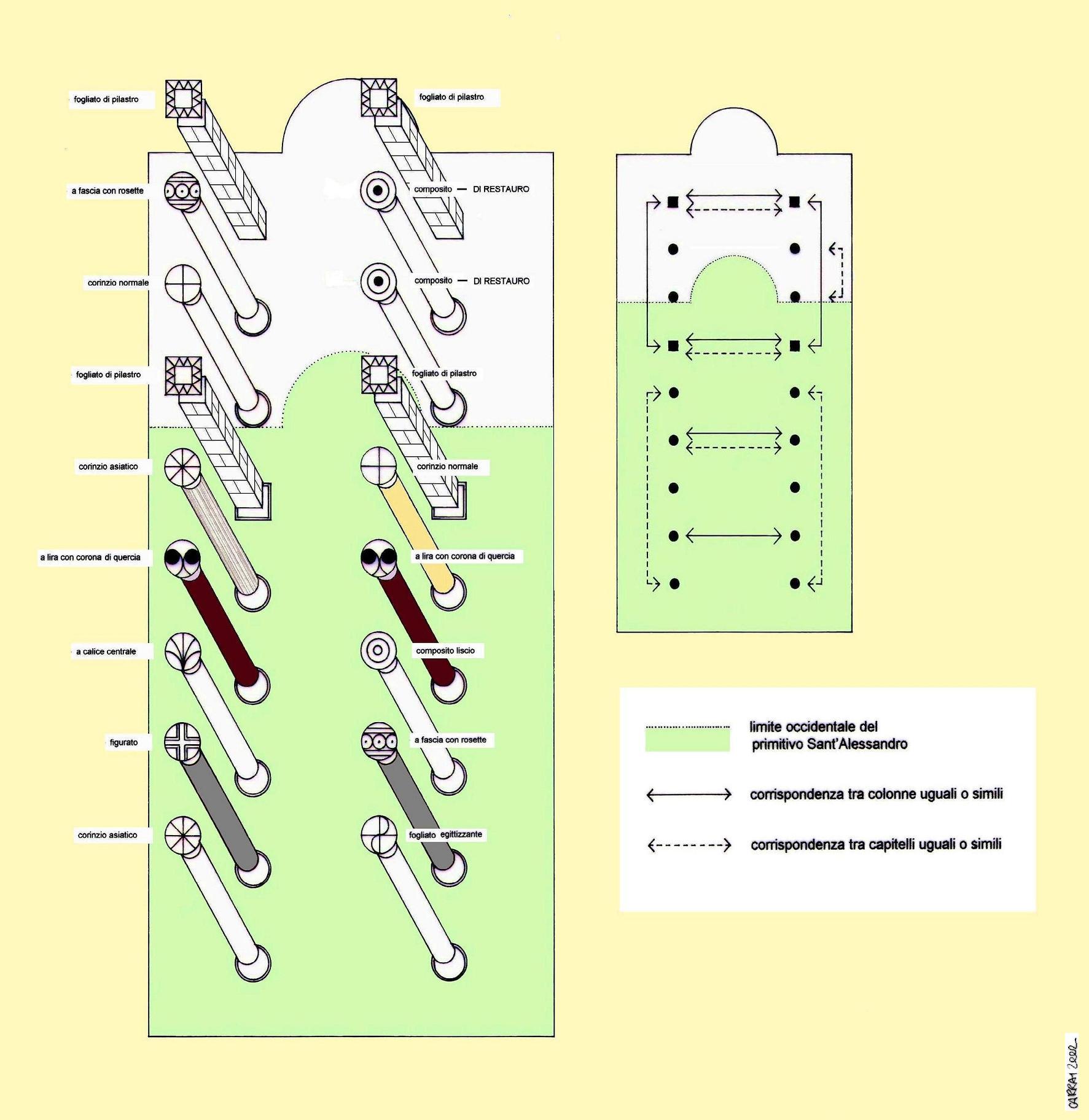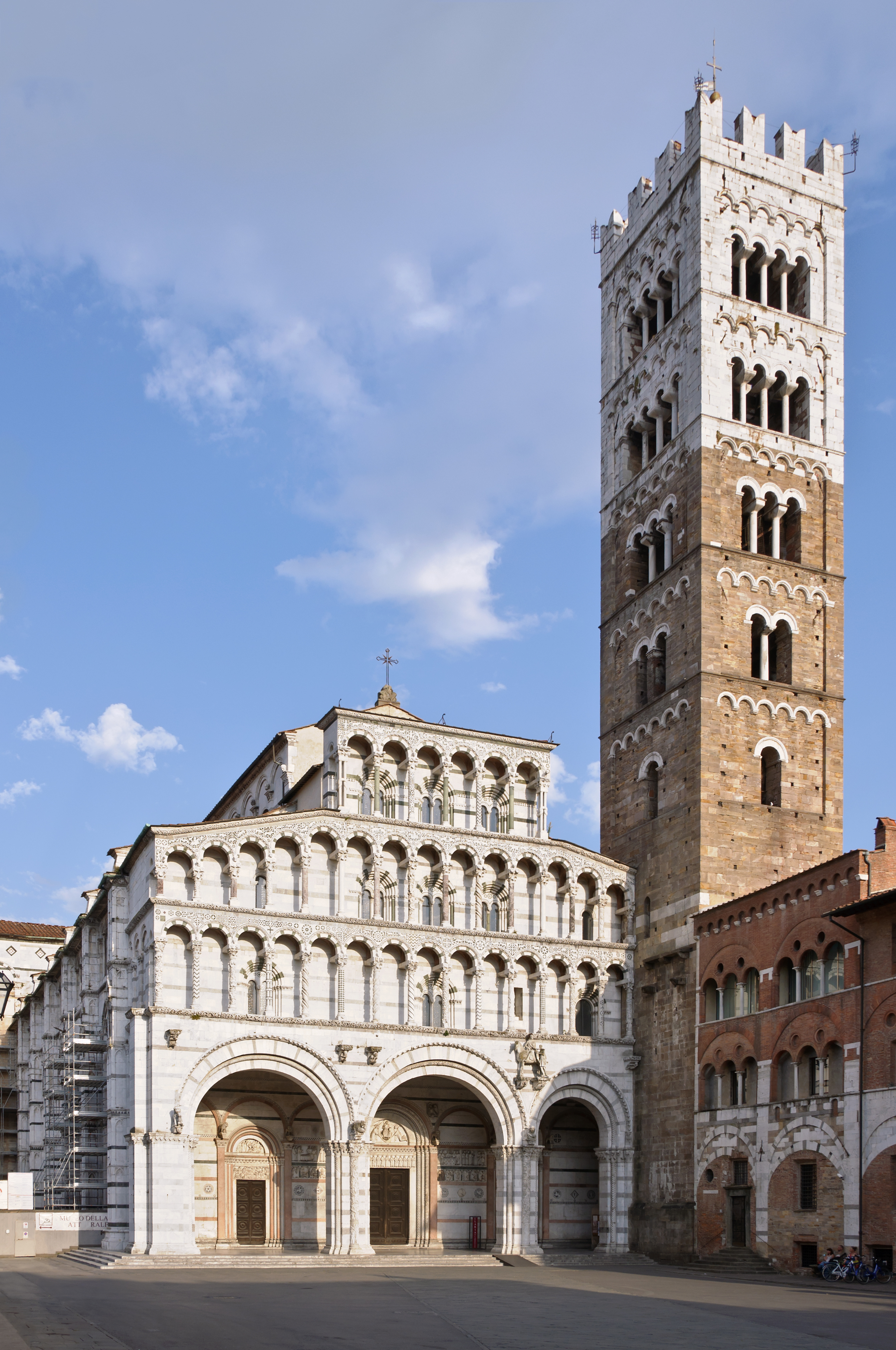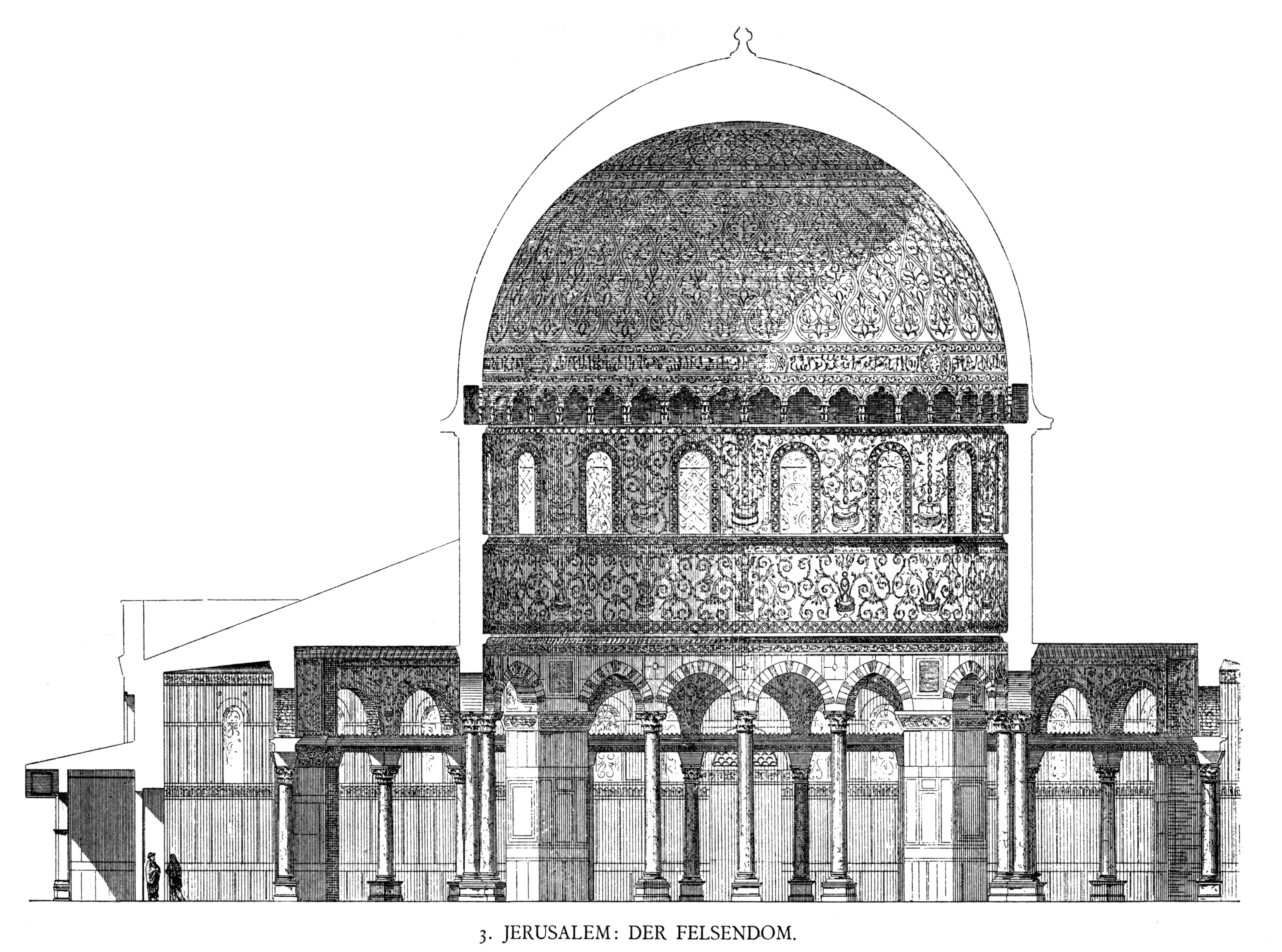|
Sant'Alessandro, Lucca
Sant’Alessandro Maggiore is a Romanesque-style, Roman Catholic parish church in Lucca, region of Tuscany, Italy. History First mentioned in a document dated 893, the layout is that of a Romanesque basilica, with little decoration, giving the facade a sober classicism. The present building, however, contains the structures of an older church, whose date of construction is still a matter of controversy, and whose features are surprisingly close to those of Roman architecture: This church is a rare and good preserved example of medieval classicism, an evidence of survival in Italy, during the Dark Ages, of Roman architectural tradition. The small building can be compared only with monuments as the Baptistry in Florence or the Basilica of San Salvatore in Spoleto. Description The building is entirely covered with perfectly polished limestone slabs and arranged in alternately high and low bands, according to an order evoking the monuments of Antiquity, this alternation has ... [...More Info...] [...Related Items...] OR: [Wikipedia] [Google] [Baidu] |
Lucca
Lucca ( , ) is a city and ''comune'' in Tuscany, Central Italy, on the Serchio River, in a fertile plain near the Ligurian Sea. The city has a population of about 89,000, while its province has a population of 383,957. Lucca is known as one of the Italian's "Città d'arte" (Arts town), thanks to its intact Renaissance-era city walls and its very well preserved historic center, where, among other buildings and monuments, are located the Piazza dell'Anfiteatro, which has its origins in the second half of the 1st century A.D. and the Guinigi Tower, a tower that dates from the 1300s. The city is also the birthplace of numerous world-class composers, including Giacomo Puccini, Alfredo Catalani, and Luigi Boccherini. Toponymy By the Romans, Lucca was known as ''Luca''. From more recent and concrete toponymic studies, the name Lucca has references that lead to "sacred wood" (Latin: ''lucus''), "to cut" (Latin: ''lucare'') and "luminous space" (''leuk'', a term used by ... [...More Info...] [...Related Items...] OR: [Wikipedia] [Google] [Baidu] |
Mausoleum Of Theodoric
The Mausoleum of Theodoric ( it, Mausoleo di Teodorico) is an ancient monument just outside Ravenna, Italy. It was built in 520 AD by Theodoric the Great, king of the Ostrogoths, as his future tomb. Description The mausoleum's current structure consists of two decagonal orders, one above the other made of Istrian stone, sourced from a quarry approximately away by land journey. The mausoleum's roof consists of a single carved stone in diameter weighing 230 tonnes. A niche leads down to a room that was probably a chapel for funeral liturgies; an external stair leads to the upper floor. Located in the centre of the upper floor is a fragmentary ancient Roman porphyry tub, likely from a bath complex, in which Theodoric was buried. His remains were removed during Byzantine rule, when the mausoleum was turned into a Christian oratory. In the late 19th century, silting from a nearby rivulet that had partly submerged the mausoleum was drained and excavated. Recognition It was inscrib ... [...More Info...] [...Related Items...] OR: [Wikipedia] [Google] [Baidu] |
9th-century Churches In Italy
The 9th century was a period from 801 ( DCCCI) through 900 ( CM) in accordance with the Julian calendar. The Carolingian Renaissance and the Viking raids occurred within this period. In the Middle East, the House of Wisdom was founded in Abbasid Baghdad, attracting many scholars to the city. The field of algebra was founded by the Muslim polymath al-Khwarizmi. The most famous Islamic Scholar Ahmad ibn Hanbal was tortured and imprisoned by Abbasid official Ahmad ibn Abi Du'ad during the reign of Abbasid caliph al-Mu'tasim and caliph al-Wathiq. In Southeast Asia, the height of the Mataram Kingdom happened in this century, while Burma would see the establishment of the major kingdom of Pagan. Tang China started the century with the effective rule under Emperor Xianzong and ended the century with the Huang Chao rebellions. While the Maya experienced widespread political collapse in the central Maya region, resulting in internecine warfare, the abandonment of cities, and a n ... [...More Info...] [...Related Items...] OR: [Wikipedia] [Google] [Baidu] |
Romanesque Architecture In Lucca
Romanesque may refer to: In art and architecture *First Romanesque, or Lombard Romanesque architectural style * Pre-Romanesque art and architecture, a term used for the early phase of the style * Romanesque architecture, architecture of Europe which emerged in the late 10th century and lasted to the 13th century **Romanesque secular and domestic architecture ** Brick Romanesque, North Germany and Baltic ** Norman architecture, the traditional term for the style in English **Spanish Romanesque **Romanesque architecture in France *Romanesque art, the art of Western Europe from approximately AD 1000 to the 13th century or later *Romanesque Revival architecture, an architectural style which started in the mid-19th century, inspired by the original Romanesque architecture **Richardsonian Romanesque Richardsonian Romanesque is a style of Romanesque Revival architecture named after the American architect Henry Hobson Richardson (1838–1886). The revival style incorporates 11th and ... [...More Info...] [...Related Items...] OR: [Wikipedia] [Google] [Baidu] |
Roman Catholic Churches In Lucca
Roman or Romans most often refers to: * Rome, the capital city of Italy * Ancient Rome, Roman civilization from 8th century BC to 5th century AD *Roman people, the people of ancient Rome *''Epistle to the Romans'', shortened to ''Romans'', a letter in the New Testament of the Christian Bible Roman or Romans may also refer to: Arts and entertainment Music *Romans (band), a Japanese pop group * ''Roman'' (album), by Sound Horizon, 2006 * ''Roman'' (EP), by Teen Top, 2011 *"Roman (My Dear Boy)", a 2004 single by Morning Musume Film and television *Film Roman, an American animation studio * ''Roman'' (film), a 2006 American suspense-horror film * ''Romans'' (2013 film), an Indian Malayalam comedy film * ''Romans'' (2017 film), a British drama film * ''The Romans'' (''Doctor Who''), a serial in British TV series People * Roman (given name), a given name, including a list of people and fictional characters * Roman (surname), including a list of people named Roman or Romans *Ῥωμ� ... [...More Info...] [...Related Items...] OR: [Wikipedia] [Google] [Baidu] |
Biduino
Biduino or Biduinus (active c. 1173 – 1194) was an Italian sculptor and architect from the Romanesque period, active around Pisa and Lucca Lucca ( , ) is a city and ''comune'' in Tuscany, Central Italy, on the Serchio River, in a fertile plain near the Ligurian Sea. The city has a population of about 89,000, while its province has a population of 383,957. Lucca is known as .... His name is attributed to having been born in Bidogno in Val, near Lugano. by Giuseppe Merzario, page 197. [...More Info...] [...Related Items...] OR: [Wikipedia] [Google] [Baidu] |
Corinthian Order
The Corinthian order ( Greek: Κορινθιακός ρυθμός, Latin: ''Ordo Corinthius'') is the last developed of the three principal classical orders of Ancient Greek architecture and Roman architecture. The other two are the Doric order which was the earliest, followed by the Ionic order. In Ancient Greek architecture, the Corinthian order follows the Ionic in almost all respects other than the capitals of the columns. When classical architecture was revived during the Renaissance, two more orders were added to the canon: the Tuscan order and the Composite order. The Corinthian, with its offshoot the Composite, is the most ornate of the orders. This architectural style is characterized by slender fluted columns and elaborate capitals decorated with acanthus leaves and scrolls. There are many variations. The name ''Corinthian'' is derived from the ancient Greek city of Corinth, although the style had its own model in Roman practice, following precedents set by ... [...More Info...] [...Related Items...] OR: [Wikipedia] [Google] [Baidu] |
Temple Of Saturn
The Temple of Saturn (Latin: ''Templum Saturni'' or ''Aedes Saturni''; it, Tempio di Saturno) was an ancient Roman temple to the god Saturn, in what is now Rome, Italy. Its ruins stand at the foot of the Capitoline Hill at the western end of the Roman Forum. The original dedication of the temple is traditionally dated to 497 BC, but ancient writers disagreed greatly about the history of this site. History Construction of the temple is thought to have begun in the later years of the Roman Kingdom under Tarquinius Superbus. Its inauguration by the consul Titus Larcius took place in the early years of the Republic, making it the oldest Republican temple after the Temple of Jupiter Optimus Maximus. The altar of Saturn, which stood in front of the temple, is thought to have been much older and was associated with Saturn's founding of the city on Capitoline Hill. The temple was completely reconstructed by Munatius Plancus in 42 BC. The present ruins represent the third phase of ... [...More Info...] [...Related Items...] OR: [Wikipedia] [Google] [Baidu] |
Basilica
In Ancient Roman architecture, a basilica is a large public building with multiple functions, typically built alongside the town's forum. The basilica was in the Latin West equivalent to a stoa in the Greek East. The building gave its name to the architectural form of the basilica. Originally, a basilica was an ancient Roman public building, where courts were held, as well as serving other official and public functions. Basilicas are typically rectangular buildings with a central nave flanked by two or more longitudinal aisles, with the roof at two levels, being higher in the centre over the nave to admit a clerestory and lower over the side-aisles. An apse at one end, or less frequently at both ends or on the side, usually contained the raised tribunal occupied by the Roman magistrates. The basilica was centrally located in every Roman town, usually adjacent to the forum and often opposite a temple in imperial-era forums. Basilicas were also built in private residences ... [...More Info...] [...Related Items...] OR: [Wikipedia] [Google] [Baidu] |
Diocletian's Palace
Diocletian's Palace ( hr, Dioklecijanova palača, ) is an ancient palace built for the Roman emperor Diocletian at the turn of the fourth century AD, which today forms about half the old town of Split, Croatia. While it is referred to as a "palace" because of its intended use as the retirement residence of Diocletian, the term can be misleading as the structure is massive and more resembles a large fortress: about half of it was for Diocletian's personal use, and the rest housed the military garrison. The complex was built on a peninsula six kilometres southwest from Salona, the former capital of Dalmatia, one of the largest cities of the late empire with 60,000 people and the birthplace of Diocletian. The terrain around Salona slopes gently seaward and is typical karst, consisting of low limestone ridges running east to west with marl in the clefts between them. Today the remains of the palace are part of the historic core of Split, which in 1979 was listed by UNESCO as a World ... [...More Info...] [...Related Items...] OR: [Wikipedia] [Google] [Baidu] |
Dome Of The Rock
The Dome of the Rock ( ar, قبة الصخرة, Qubbat aṣ-Ṣakhra) is an Islamic shrine located on the Temple Mount in the Old City of Jerusalem, a site also known to Muslims as the ''al-Haram al-Sharif'' or the Al-Aqsa Compound. Its initial construction was undertaken by the Umayyad Caliphate on the orders of Abd al-Malik during the Second Fitna in 691–692 CE, and it has since been situated on top of the site of the Second Jewish Temple (built in to replace the destroyed Solomon's Temple), which was destroyed by the Romans in 70 CE. The original dome collapsed in 1015 and was rebuilt in 1022–23. The Dome of the Rock is the world's oldest surviving work of Islamic architecture. Its architecture and mosaics were patterned after nearby Byzantine churches and palaces, although its outside appearance was significantly changed during the Ottoman period and again in the modern period, notably with the addition of the gold-plated roof, in 1959–61 and again in 1993. The ... [...More Info...] [...Related Items...] OR: [Wikipedia] [Google] [Baidu] |
Ravenna
Ravenna ( , , also ; rgn, Ravèna) is the capital city of the Province of Ravenna, in the Emilia-Romagna region of Northern Italy. It was the capital city of the Western Roman Empire from 408 until its collapse in 476. It then served as the capital of the Ostrogothic Kingdom until it was re-conquered in 540 by the Byzantine Empire. Afterwards, the city formed the centre of the Byzantine Exarchate of Ravenna until the last exarch was executed by the Lombards in 751. Although it is an inland city, Ravenna is connected to the Adriatic Sea by the Candiano Canal. It is known for its well-preserved late Roman and Byzantine architecture, with eight buildings comprising the UNESCO World Heritage Site "Early Christian Monuments of Ravenna". History The origin of the name ''Ravenna'' is unclear. Some have speculated that "Ravenna" is related to "Rasenna" (or "Rasna"), the term that the Etruscans used for themselves, but there is no agreement on this point. Ancient era The origins o ... [...More Info...] [...Related Items...] OR: [Wikipedia] [Google] [Baidu] |



.jpg)

.jpg)

.png)